Giacomo Ariosto de Bologna
Raimondello was born at Nocera Inferiore, the second son of Nicola Orsini (1331–1399), 3rd Count of Nola, grand Justiciar and also Grand Chancellor of the Kingdom of Naples, and his second wife Maria Del Balzo (of the counts of Soleto). His grandfather was Roberto Orsini di Nola (1295–1345), 2nd Count of Nola, Grand Justiciar of Naples. His grandmother was the heiress Sveva Del Balzo (born in the first years of 14th century), Countess of Soleto, heiress of des Baux. The family is later known as del Balzo Orsini. His full brother Roberto was 4th Count of Nola, died 1400 and left only illegitimate issue, however natural son inherited County of Nola and became Grand Justiciar. One of his sisters, Sveva, married Francesco Del Balzo, Duke of Andria. His father and grandfather also held the title of Senator of Rome.
Her paternal grandmother Isabella survived her brother Walter VI of Brienne, titular Duke of Athens etc., who died without surviving issue in 1356 at the Battle of Poitiers. As his heir, she became Countess of Lecce and Brienne etc., as well as titular Duchess of Athens. Since her eldest son Walter had died before her brother, her heir was her second son Sohier of Enghien. She allowed her inherited lands to be divided between her numerous children during her own lifetime. Mary's father, the third (but second surviving) son, had received the County of Lecce and the lordship of Castro.
Padres
Federico II Paolo Novello da Montefeltro (died c. 1370) was Count of Urbino from 1364 until his death. He was the son of Nolfo da Montefeltro. He had four sons, of which Antonio returned to become Count of Urbino in 1364
|
|
|
|
Parents
Parents
John II, Count of Nevers (known as Jean de Clamecy, prior to acquiring title of "Count of Nevers"; 1415–1491) was a French noble.
He was the son of Philip II, Count of Nevers by his wife, Bonne of Artois, daughter of Philip of Artois, Count of Eu. John's elder brother, Charles I, Count of Nevers and Rethel, had no legitimate children, and so on his death in 1464 his titles passed to John. In 1472, his uncle Charles of Artois, Count of Eu, died, and having no legitimate children, his title also passed to John.
Philipp I of Katzenelnbogen (1402–1479), also known "Philipp the Elder" was Count of Katzenelnbogen from 1444 to 1479 and was the last male descendant of the Counts of Katzenelnbogen (his two sons died before him). His parents were Johann IV, Count of Katzenelnbogen (younger line) and Anne of Katzenelnbogen (older line), who merged the two lines of the family back together in 1402.
Adelheid of Tecklenburg, daughter of Nicholas II, Count of Tecklenburg and Elisabeth of Moers
He was a son of Eric IV, Duke of Saxe-Lauenburg and Sophia of Brunswick-Lüneburg. Since long Bernard urged his ruling brother Eric V to share his reign. Failed in his fight for the Saxon electorate Eric finally agreed and made Bernard the co-duke of Saxe-Lauenburg in 1426. [1] When Eric V died in 1435 Bernard continued the reign alone.
John II (26 April 1319 – 8 April 1364), or Jean II, also called John the Good (French: Jean le Bon), was a monarch of the House of Valois who ruled as King of France from 1350 until his death.
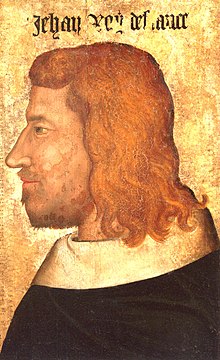


Isabeau of Melun (1328–1389),[4] daughter of John I of Melun, Count of Tancarville
Joan of Armagnac (French: Jeanne d'Armagnac; 24 June 1346 – 1387) was a French noblewoman of the Armagnac family, being the eldest daughter of Count John I of Armagnac and his wife Beatrice of Clermont.

Otón I de Hesse (c. 1272 -17 de enero de 1328) fue Landgrave de Hesse desde 1308 hasta su muerte.

Otto, Lord of Lippe ( c. 1300 – c. 1360) was the ruling Count of Lippe-Lemgo from 1344 until his death.
Irmgard of the Marck
Otto II, Count of Waldeck (before 1307 – 1369) was Count of Waldeck from 1344 until his death.
Otto was the son of Count Henry IV of Waldeck and his wife Adelaide of Cleves.
Matilda, a daughter of Duke Otto III of Brunswick-Luneburg
Adolph I, Count of Nassau-Wiesbaden-Idstein (1307 – 17 January 1370) was a son of Count Gerlach I and Agnes of Hesse

Silver groat or 'voetdrager', struck under Albert of Bavaria.
Mintplace: Dordrecht 1389-1404.

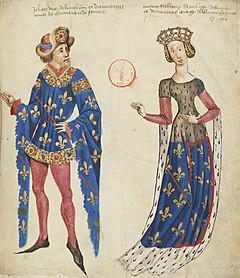
Louis the Junker of Hesse (1305 – 2 February 1345) was a German nobleman. He was the third son of Landgrave Otto I ofHesse and his wife Adelheid, a daughter of Otto III of Ravensberg.
Elisabeth (or Elise), a daughter of Count Simon II of Sponheim-Kreuznach
He was the elder son of John II of Nuremberg and Elisabeth of Henneberg. From the death of his father in 1357, Frederick bore the title of Burgrave and so was responsible for the protection of the strategically significant imperial castle of Nuremberg. His zeal in the imperial cause led Charles IV to elevate him in 1363 to be the first Burgrave of royal rank.
Catherine of Henneberg ( German: Katharina von Henneberg ; c. 1334, Schleusingen – 15 July 1397, Meissen) was a Countess of Henneberg by birth and from 1347 by marriage Margravine of Meissen, Landgravine of Thuringia, etc. She was the wife of Margrave Frederick the Severe of Meissen. Via her, the House of Wettin inherited her father's Franconian possessions.
Catherine was the second of four daughters of Count Henry IV of Henneberg-Schleusingen and his wife Judith of Brandenburg-Salzwedel.

Rudolf VI of Baden (died 21 March 1372) was Margrave of Baden-Baden and Count of Eberstein from 1353 to 1372.
luis XI Oettingen
- Deceased 28 October 1440 (Wednesday)
Parents
Conrad I of Oldenburg ( German: Konrad I. von Oldenburg; died 1367) was the Count of Oldenburg from 1344 to 1367. He succeeded his brother, John III of Oldenburg.
Dietrich V (VI) von Honstein-Heringen, Duke
|
Albert II, Prince of Anhalt-Zerbst (died 17 July 1362) was a German prince of the House of Ascania and ruler of the principality of Anhalt-Zerbst.
Boček II of Poděbrady (also: Boček II of Kunštát and Poděbrady; German: Boček II. von Kunstadt und Podiebrad or Botschek von Podiebrad or Botschek der Ältere von Podiebrad; Czech: Boček II. z Poděbrad or Boček II. z Kunštátu a Poděbrad or Boček starší z Poděbrad; died: 1417) may have been treasurer or even chief treasurer of Bohemia between 1377 and 1387. Between 1403 and 1408, he held the office of Oberstlandschreiber ("chief administrator") of Bohemia.
It is not known when and where Boček II was born. His parents were Boček I of Poděbrady and Elisabeth of Lichtemburk ( German: Elisabeth von Lichtenburg; Czech: Eliska z Lichtemburka), a daughter of Henry of Lichtenburg at Žleby Castle.
Anna Elisabeth Lipa (Czech: Anna Eliška Lipá), a daughter of Henry of Leipa (Czech: Jindřich Lipá)
|
Albert IV of Austria (19 September 1377 – 14 September 1404) was a Duke of Austria.
Sigismund of Luxemburg (14 February 1368 – 9 December 1437) was Prince-elector of Brandenburg from 1378 until 1388 and from 1411 until 1415, King of Hungary and Croatia from 1387, King of Germany from 1411, King of Bohemia from 1419, King of Italyfrom 1431, and Holy Roman Emperor for four years from 1433 until 1437, the last male member of the House of Luxemburg.[1] He was regarded as highly educated, spoke several languages (among them French, German, Hungarian, Italian, and Latin) and was an outgoing person who also took pleasure in the tournament.
Barbara of Cilli (1392 – 11 July 1451), was the spouse of Holy Roman Emperor Sigismund and as such Holy Roman Empress. She was by marriage also Queen of Hungary and Bohemia. She was actively involved in politics and economy of her times, independently administering large feudal fiefdoms and taxes, and was instrumental in creating famous royal Order of the Dragon. She served as the regent of Hungarian kingdom in the absence of her husband.
Magnus (1324–1373), called Magnus with the Necklace ( Latin: Magnus Torquatus) or Magnus II, was Duke of Brunswick-Lüneburg, ruling the Brunswick-Lüneburg principalities of Wolfenbüttel (colloquially also called Brunswick) and, temporarily, Lüneburg.
Elisabeth of Lindow-Ruppin
Barnim IV of Pomerania (1325 – 22 August 1365) was a Duke of Pomerania-Wolgast-Rügen.
He was the second son of Duke WartislawIV of Pomerania-Wolgast
|
Count Henry II of Holstein-Rendsburg (nickname Iron Henry; c. 1317 – c. 1384) was count of Holstein-Rendsburg and pledge lord of Southern Schleswig. He ruled jointly with his younger brother, Count Nicholas (d. 1397).
Henry was the elder son of Count Gerhard III and Sophia of Werle.
Algirdas was one of the seven sons of Grand Prince Gediminas

Eberhard II, called "der Greiner" (the Jarrer) (after 1315 – 15 March 1392, Stuttgart), Count of Württemberg from 1344 until 1392.
Bernabò or Barnabò Visconti (1323 – 18 December 1385) was an Italian soldier and statesman, who was Lord of Milan.
Beatrice Regina della Scala (1331 – 18 June 1384) was an Italian noblewoman, a member of the Scaliger family of Northern Italy. She was the wife of Bernabò Visconti, Lord of Milan, and the mother of his seventeen legitimate children.
Beatrice Regina was born in Verona in 1331,[1] the youngest child and only daughter of Mastino II della Scala and Taddea da Carrara
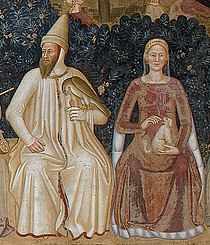

Albert III of Austria (9 September 1349 – 29 August 1395), known as Albert with the Braid ( German: Albrecht mit dem Zopf), a member of the House of Habsburg, was Duke of Austria from 1365 until his death.
Margaret of Brieg (1342–1386) was a daughter of Ludwik I the Fair and his wife, Agnes of Sagan.
Otón I de Hesse (c. 1272 -17 de enero de 1328) fue Landgrave de Hesse desde 1308 hasta su muerte.
Federico III Wettin Wittelsbach
(Federico Wettin Wittelsbach)
Federico III de Thuringia , Federico III el Estricto
Landgrave Thuringia (1349-1381), Margrave Meissen (1349-1381)
- Nacido el 14 de diciembre 1332 - Dresden, Sachsen, Deutschland
- Fallecido el 21 de mayo 1381 - Altenburg, Alemania , a la edad de 48 años
Padres
Enrique de Brunswick-Lüneburg (del latín Henricus, murió el 14 de octubre 1416), duque de Brunswick-Lüneburg, llamado Enrique el Apacible, fue príncipe de Lüneburgdesde 1388 a 1409, junto con su hermano Bernardo I de Brunswick-Lüneburg, desde 1400 hasta 1409 fue también príncipe de Wolfenbüttel, y desde 1409 hasta su muerte, el único príncipe de Lüneburg.
Burcardo I (... – 1061) fu il primo Conte di Zollern e capostipite della casata degli Hohenzollern.

Agnese del Palatinato, figlia di Enrico V della dinastia dei Guelfi
Gertrude was born to Burkhard V, Count of Hohenberg (d. 1253), and his wife, Matilda of Tübingen.
Margrave Otto V of Brandenburg-Salzwedel (c. 1246 – 1298), nicknamed Otto the Tall, was a son of Margrave Otto III and co-ruler of Brandenburg with his cousin, Margrave Otto IV.
Judith of Henneberg-Coburg, a daughter of Count Herman I of Henneberg.
Isabel nació en 1240 como hija de un príncipe cumano de nombre desconocido (se estima que era Kuthen /Kötöny, el líder que arribó con su gente a Hungría en 1239 y que pactó numerosos acuerdos amistosos con el rey Bela IV)

Pope Gregory X

|
Squarcino era figlio di Lanfranco dei Borri (fine XII - inizio XIII secolo), signore feudale locale della città di Santo Stefano Ticino
Egli era un nobile genovese della celebre famiglia dei Doria, figlio di Nicolò. Ebbe vari incarichi politici in Sardegna e fu antenato del successivo Branca Doria che lottò contro il dominio degli Aragonesi. I genitori erano Nicolò Doria, genovese, e Preziosa di Torres, sarda, della famiglia dei Lacon, già imparentata con i Doria. Preziosa era figlia illegittima del Giudice di Torres Mariano II. Genova in questo periodo si batteva con Pisa per il potere sulla Sardegna, e le famiglie particolarmente interessate in questa competizione erano i Doria e i Malaspina.
|
|
Era figlia dei conti di Salizzole, i "de Salicoelis" [
Di Giberto III non si conosce né la data né il luogo di nascita esatto, figlio di Guido II da Correggio e di Mabilia della Gente,
Elena Malaspina, figlia del marchese di Morello Malaspina Mulazzo
Figlio di Marco, fu illustre politico e uomo risoluto e deciso, pronto a mettersi contro il papato e ad imporre i voleri di Venezia alle città più deboli. Durante il suo mandato si verificò la cosiddetta Serrata del Maggior Consiglio (28 febbraio 1297) ed in seguito a ciò vi furono tentativi da parte dei "borghesi" esclusi di prendere il potere che si concretizzarono in due tentati colpi di stato ( Marin Bocconio, 1299 o 1300 e Bajamonte Tiepolo, 1310). Nel 1310 in seguito a queste congiure nacque il famoso Consiglio dei Dieci. Sotto di lui la Repubblica rischiò di distruggersi in una logorante guerra civile, ma sconfitti gli avversari più potenti riuscì a placare la situazione e a far vincere la sua fazione che plasmò Venezia in senso oligarchico.

|
|
|
|
olesław II of Masovia or Bolesław II of Płock (pl: Bolesław II mazowiecki (płocki); ca. 1253/58 [1] – 20 April 1313), was a Polish prince member of the House of Piast, Duke of Masovia during 1262-1275 jointly with his brother, since 1275 sole ruler over Płock, since 1294 ruler over all Masovia and Duke of Kraków and Sandomierz during 1288-1289. [2] In 1310 he gave to his sons the districts of Warsaw and Czersk.
Yuri I of Galicia (24 April 1252 (1257?) – 18 March 1308) was a King of Rus', Prince of Volhynia ( Latin: Regis Rusie, Princeps Ladimerie). His full title was Yuri I, King of Ruthenia, Grand Prince of Kiev, Volydymyr-Volhynia, Halych, Lutsk, Dorohochyn.
Przemysław of Racibórz ( Polish: Przemysław raciborski) (between 21 October 1258 and 12 June 1268 – 7 May 1306) was a Duke of Racibórz since 1282 until his death (until 1290 with his brother as co-ruler).
Anna of Masovia (c. 1270-after July 13, 1324 [1]) was a Princess of Masovia and was a member of the House of Piast.
Butvydas (or Pukuveras) (Belarusian: Будзівід; also known as Боудивидъ, Liutauras, Pukuwer or Pucuwerus) (died 1295) was the Grand Duke of Lithuania from 1292 to 1295. His influence was strong during his brother Butigeidis' reign. This led some historians to believe, that they were co-rulers, much like the grandsons Algirdas and Kęstutis. During his short reign Butvydas tried to defend the duchy against the Teutonic Knights; he also attacked Masovia, an ally of the knights. He was a direct ancestor of the Gediminids.
Fu il secondogenito del Principe Jaroslav III, fratello di Aleksandr Nevskij, e successe al padre nel 1285, quando questi spirò dopo essersi fatto ordinare monaco in punto di morte. La madre Ksenija, che vista la giovane età del figlio aveva un ruolo importante nella reggenza del principato e nell'educazione di quest'ultimo, crebbe Michele in una rigida formazione religiosa. Alla morte del PrincipeAndrej Aleksandrovič, Michele fu convocato dal Khan dell'Orda d'Oro che lo nominò Gran Principe di Vladimir e, primo tra i sovrani russi, si autoproclamò Gran Principe di tutta la Rus'.


Mariya Yaroslavna
3 Photos and 105,436 Family Trees
Born in Murom, Vladimir Oblast, Russia on 1232 to Yaroslav Yurevich and Mrs Yaroslav Yurevich. Mariya married Boris Of Rostov and had 4 children. She passed away on 1297 in Rostov, Yaroslavl, Russia.
Era hija de Burkard V, conde de Hohenberg (m. 1253) y su esposa Mechtilde de Tubinga.
Jun I de Brabante, llamado el Victorioso (c. 1251 - 1294), fue duque de Brabante desde 1267 y duque de Limburgo a partir de 1288 y hasta su muerte. Sucedió en el ducado a su hermano Enrique IV, quien renunció a la corona ducal al alcanzar la mayoría de edad. Fue hijo de Enrique III, duque de Brabante, y de Adelaida de Borgoña.
Albert (Latin Albertus; c. 1268 – 22 September 1318), called the Fat ( pinguis), was duke of Brunswick-Lüneburg.
Henry was a son of Margrave John I of Brandenburg and his third wife, Jutta, the daughter of Duke Albert I of Saxony.
Agnes of Bavaria (1276-1345) was a daughter of Duke Louis II of Upper Bavaria (1229–1294) and his third wife, Matilda of Habsburg (1253–1304).
Bolko I di Schweidnitz, detto il Severo, noto anche come (in lingua tedesca) Bolko I. von Jauer und Schweidnitz, Boleslaw III. von Liegnitz, in polacco Bolko I Surowy, in ceco Boleslav I. Javorsko-Svídnický Surový (1253 circa – 9 novembre 1301), fu duca di Jawordal 1278 e duca di Löwenberg dal 1286. Egli apparteneva alla dinastia dei Piast. I suoi genitori erano Boleslao II, duca di Slesia, e dal 1248 anche duca di Liegnitz, ed Edvige († 1259), figlia del conte Enrico I di Anhalt.
Beatrice († 1316), una delle figlie del margravio Ottone V di Brandeburgo
Pietro [1][2][3] era figlio di Giacomo I, re d'Aragona, di Valencia e Maiorca e conte di Barcellona, Girona, Osona, Besalú, Cerdagna e di Rossiglione, signore di Montpellier e Carladès, detto anche Giacomo il Conquistatore, e di Violante, figlia del re di Ungheria, Andrea II e della principessa di Costantinopoli, Iolanda di Courtenay.
.
|
. Carlo II d'Angiò, detto lo Zoppo (1254 – Napoli, 5 maggio 1309), fu principe di Salerno dal 1266, poi conte d'Angiò e del Maine,conte di Provenza e Forcalquier, re di Napoli (1285-1309) e re titolare di Sicilia (1285-1302), principe di Taranto, re d'Albania,principe d'Acaia e re titolare di Gerusalemme, con il nome di Carlo II.
Membro della casata degli Ascanidi, Alberto era il figlio maggiore del duca Bernardo III di Sassonia e di Brigitta di Danimarca, figlia del reCanuto V di Danimarca.
Sigismondo era figlio dell'imperatore Carlo IV, e fratellastro di un altro imperatore, Venceslao (Sigismondo era nato dal matrimonio di Carlo con Elisabetta di Pomerania, mentre Venceslao era nato dall'unione tra Carlo e Anna di Schweidnitz). Era considerato molto colto, parlava molte lingue (tra cui tedesco, latino, italiano e francese) e, a differenza del padre, un uomo amante della vita, che amava anche partecipare ai tornei cavallereschi.
Barbara era una figlia di Ermanno II, conte di Cilli ( Celje), e della contessa Anna di Schauenburg. I nonni paterni di Barbara erano quindi Ermanno I di Cilli e la moglie Caterina di Bosnia, probabilmente sorella di Elisabetta di Bosnia. I nonni materni di Barbara erano invece Enrico III di Schauenburg e Ursula di Görz.
Duke Wartislaw IX of Pomerania-Wolgast (c. 1400 – 17 April 1457, Wolgast) was the eldest son of the Duke Barnim VI, Duke of Pomerania and Veronica. Europaische Stammtafaln does not cite an origin for Veronica
Edvige di Polonia, nota anche come Edvige d'Angiò o Jadwiga ( Buda, 1373- 1374 – Cracovia, 17 luglio 1399), fu regina (ufficialmente, però, il suo titolo era "re" anziché "regina", per indicare che regnava per suo diritto e non in quanto consorte di re) di Polonia di origine ungherese.
Figlio di Federico IV e di Margherita di Carinzia, ottenuti i titoli di burgravio di Norimberga, Bayreuth e Ansbach alla morte del padre, gli succedette l'unico figlio, Federico V.
Stefano II di Wittelsbach ( 1319 – 1375) Duca di Baviera dal 1347 alla sua morte.

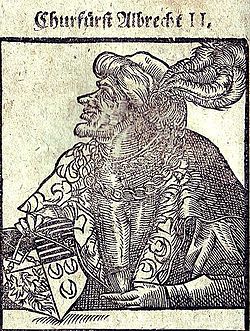
Jacopo II da Carrara (or Giacomo II) (died 1350), of the Carraresi family, was the capitano del popolo of Padua from 1345 until his death. Though he assumed power through forged documents and political murder, he was a patron of art and literature. He succeeded in bringing Francesco Petrarca to Padua for a time, and his own son, Francesco I, was an artisan. Jacopo also introduced the carrarino as the currency of Padua.
Berthold VII, Count of Henneberg-Schleusingen (nicknamed the Wise, born: 1272 in Schleusingen; died: 13 April 1340, Schleusingen) was Count of Henneberg- Schleusingen from 1284 to 1340. He was the son of Count Berthold V of Henneberg-Schleusingen (d. 1284) and his wife Sophie of Schwarzburg (d. 1279), the daughter of Count Günther VII of Schwarzburg. He was confirmed as Imperial Prince by Emperor Henry VI in 1310.
Adelheid (1268–1317), the daughter of Henry I of Hesse.
Beatrice of Silesia (also known as Beatrice of Świdnica; Polish: Beatrycze Świdnicka, German: Beatrix von Schweidnitz ; 1290 – 25 August 1322), was a Polish princess member of the House of Piast in the Silesian branch of Jawor- Świdnica and by marriage Duchess of Bavaria and German Queen.
Frederick II (or III) (13 December 1272 – 25 June 1337) was the regent (from 1291) and subsequently King of Sicily from 1295 until his death. He was the third son of Peter III of Aragon
- Margaret of Habsburg, daughter of Everhard I of Kiburg-Laufenburg.
John I, Lord of Polanen ( c. 1285 – 26 September 1342) was Lord of Polanen, Lord of De Lek and Lord of Breda.
He was a son of Philips III van Duivenvoorde en Elisabeth van Vianen


Sophia of Brandenburg-Stendal (1300-1356) was a daughter of Margrave Henry I (1256–1318) and his wife Agnes of Bavaria(1276–1345).
Bernhard III, Prince of Anhalt-Bernburg (died 20 August 1348) was a German prince of the House of Ascania and ruler of the principality of Anhalt-Bernburg.
Barnim IV of Pomerania (1325 – 22 August 1365) was a Duke of Pomerania-Wolgast-Rügen.
He was the second son of Duke WartislawIV of Pomerania-Wolgast and the brother of Bogislaw V and Wartislaw V.
John I, Duke of Mecklenburg [-Stargard] (1326 - 9 August 1392/9 February 1393), was from 1344 to 1352 Duke of Mecklenburgfrom 1344 to 1352 and Duke of Mecklenburg-Stargard from 1352 to 1392.
Anna was a daughter of the count Adolf VII of Pinneberg and Schauenburg.
Albert II of Gorizia (German: Albrecht II., Graf von Görz) was a son of Count Albert I of Gorizia and his wife, Euphemia of Silesia-Glogau
Euphemia of Mätsch, daughter of bailiff Ulrich II.
Count Ulrich V of Pfannberg (1287 – 23 October 1354) was Count of Pfannberg. From 1322 to 1337, he was governor of Gornji Grad and from 1330 Marshal of the Duchy of Austria. From 1330 to 1335, he was also governor of Carinthia.
He was the son of Count Ulrich IV and Margaret of Heunburg.
Margaret, the daughter of Count Hugh II of Werdenberg and Euphemia of Ortenburg
Hermann II Ottoson von Everstein-Polle, Graf von Everstein-Polle 1260-1350
Albert (Latin Albertus; c. 1268 – 22 September 1318), called the Fat (pinguis), was duke of Brunswick-Lüneburg.
Henry II of Hesse (German: Heinrich), (c. 1299 – 3 June 1376) called "the Iron" was Landgrave of Hesse from 1328 - 1376.
Rupert II, Count Palatine of the Rhine ( German: Ruprecht II., der Harte (der Ernste)) (12 May 1325, Amberg – 6 January 1398, Amberg). He was the Elector Palatine of the Rhine from the house of Wittelsbach in 1390–1398.
Henry II, Lord of Mecklenburg, nicknamed the Lion (after 14 April 1266 – 21 January 1329 in Sternberg) was regent ofMecklenburg from 1287 to 1298, co-regent from 1298 to 1302 and ruled alone again from 1302 to 1329. Henry I, Lord of Mecklenburg
Eric Magnusson (1282–1318) was a Swedish prince, Duke of Svealand, Södermanland, Dalsland, Västergötland, Värmland and North Halland and heir to the throne of Sweden. He was the father of King Magnus who became king of both Norway and Sweden.[
Ingeborg of Norway ( Duchess Ingeborg, Old Norse Ingibjörg Hákonardóttir, Swedish Ingeborg Håkansdotter, NorwegianIngebjørg Håkonsdatter; 1301 – 17 June 1361), was a Norwegian and by marriage Swedish princess and royal duchess with a position in the regency governments in Norway (1319–27) and Sweden (1319–26). In 1318-1319 she was Sweden's first de factofemale ruler [1] and her position subsequently equalled that of an undeclared queen mother for over 40 years. [2] In 1319-1326, she was Sweden's first de jure female regent.
John II, Lord of Werle[-Güstrow] nicknamed The Bald (after 1250 – 27 August 1337), was from 1309 to 1316 co-regent of Werleand from 1316 to 1337 Lord of Werle-Güstrow. He was the second eldest son of John I of Werle and Sophie of Lindow-Ruppin.



Sophia of Brandenburg-Stendal (1300-1356) was a daughter of Margrave Henry I (1256–1318) and his wife Agnes of Bavaria(1276–1345).
Bernhard III, Prince of Anhalt-Bernburg (died 20 August 1348) was a German prince of the House of Ascania and ruler of the principality of Anhalt-Bernburg.
Adelheid of Everstein-Polle (died after 29 September 1373), daughter of Count Henry II of Eberstein
Gerhard III of Holstein-Rendsburg ( c. 1292 – 1 April 1340), sometimes called Gerhard the Great, and in Denmark also known as Count Gert or den kullede greve ("the bald count"), was a German prince who ruled Schauenburg and Holstein- Rendsburg and during the interregnum of 1332–40 also a large part of Denmark.
Trojden I (1284/86 [1] – 13 March 1341), was a Polish prince member of the House of Piast, Duke of Czersk since 1310, ruler over Warsaw and Liw since 1313, regent of Płock during 1336–1340.
Nicholas II of Opava was a member of the Opava branch of the Bohemian noble Přemyslovci family. His parents were Duke Nicholas I of Opava, who had held Opava since 1269, and Adelheid of Habsburg, a niece of King Rudolf I.
Frederick III of Baden (1327 – 2 September 1353) was Margrave of Baden from 1348 to 1353.
Johann III, Count of Sponheim-Starkenburg, the Older (b. ca. 1315 – d. 30 December 1398), reigned over the County of Sponheim for 67 years. He also received many epithets such as "the Noble" and, because of his declining vision, "the Blind".
Johann III of Sponheim was the first son of Count Heinrich II of Sponheim and Loretta of Salm.
. Mechthild of the Palatinate (d. 1375). She was a daughter of the Count Palatine of the Rhine Rudolf I and Mechthild of Nassau.
|
Adelheid of Vianden, daughter of Philip of Vianden and Adelheid of Arnsberg.
Oda of Horne-Altena (1318-1353)
(Johan) Ii van Salm y Philippa van Salm
Era hija de Sir John Drummond de Stobhall y Mary Montifex
Juan Beaufort nació en el castillo Beaufort -de donde toma el apellido-, en el condado de Anjou, en Francia, entre 1371 y 1373, siendo el mayor de los cuatro hijos extramatrimoniales de Juan de Gante, duque de Lancaster, y de Catalina de Roet-Swynford.
|
|
|
|
|
|
|
|
|
|











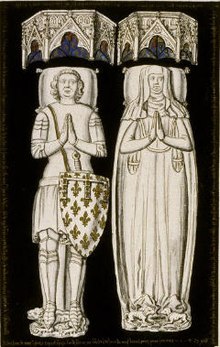



















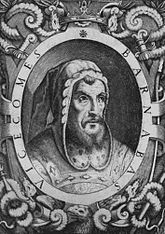


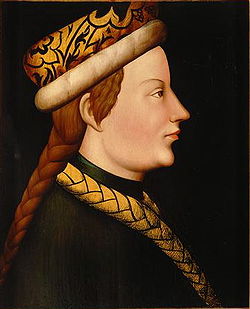






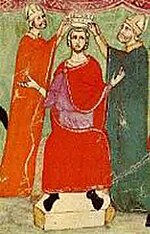







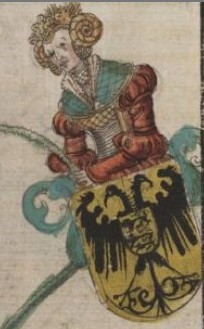

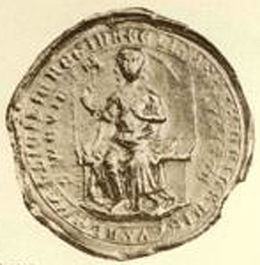









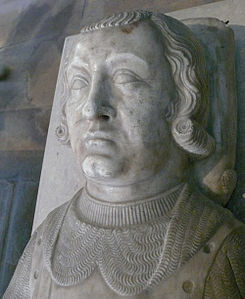

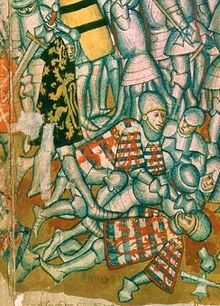




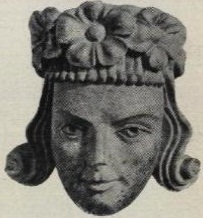






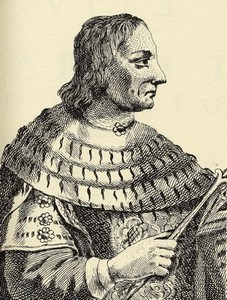
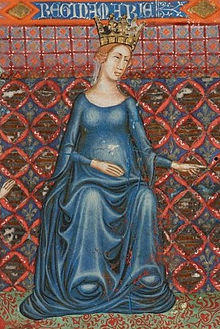
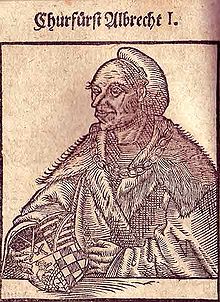





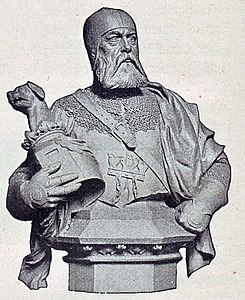










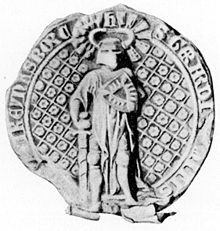




No hay comentarios:
Publicar un comentario